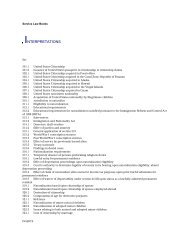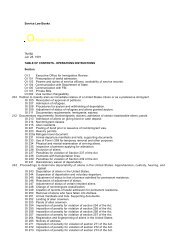Create successful ePaper yourself
Turn your PDF publications into a flip-book with our unique Google optimized e-Paper software.
<strong>Inspector's</strong> <strong>Field</strong> <strong>Manual</strong><br />
admission will be for 15 days. Stamp the passport with the appropriate endorsement. Staple Form I-94 to the<br />
top of Form I-736 and route to the contractor.<br />
(d) Refusals. Aliens who attempt entry under the GVWP, but are found inadmissible by the inspecting officer,<br />
are removed from the U.S. without further administrative hearing, unless they seek asylum. The port director or<br />
officer-in-charge, or an officer acting in that capacity, has the authority to order removal of an applicant under<br />
this provision. Because the inspecting officer's decision is, as a practical matter, final, you must exercise<br />
particular care to ensure removals are handled fairly and thoroughly documented. The conduct of the Service in<br />
administering this program is still closely monitored. For handling GVWP applicants seeking asylum, use the<br />
same I-863 referral procedures as for VWPP applicants as discussed in Chapter 15.7(e).<br />
Ensure the Form I-736 for a refused GVWP applicant is completed and signed. If the alien declines to sign the<br />
I-736, he or she is not considered a GVWP applicant. In that case, follow procedures outlined in Chapter 17.6, for<br />
institution of removal proceedings. In addition, prepare a memorandum of facts for institution of fine<br />
proceedings against the carrier, as described in Chapter 43.3.<br />
If the alien has signed the I-736, open an "A"file, take a sworn statement to establish inadmissibility, and endorse<br />
the passport with the file number, date, and port code. Endorse both portions of the I-94 with "refused," the<br />
applicable INA section, and line stamp or enter the date, port, and your stamp number. Enter the reason for<br />
refusal in block 26 of the form. Provide the alien a copy of the sworn statement and a copy of the I-94, free of<br />
reference to any lookout intercept. Prepare and serve Form I-259, Notice to Detain, Remove, or Present Aliens, on<br />
the responsible carrier to remove the alien. Prepare a lookout request as described in Chapter 31.5 Forward the<br />
arrival section of the I-94 stapled to the top of the Form I-736 for data entry. Photocopy the cover, data page, and<br />
any other relevant passport pages, as well as any other relevant materials. Distribute copies of these materials to<br />
the A file, consular post having jurisdiction over the alien's permanent residence and the port-of-entry file. Ports<br />
are required to maintain records of GVWP refusals for one year.<br />
Refusals under the GVWP will be shown in the NIIS system as class "GR".<br />
15.9 Border Crossing Card (BCC) Admissions.<br />
(a) General. The term "border crossing card" is somewhat confusing, since it actually refers to several different<br />
documents, issued to different categories of nonimmigrants for different purposes. First is the Mexican Border<br />
Crossing Card, Form I-186/586, the most commonly used border crossing card. It is issued by INS to Mexican<br />
nationals and is used in lieu of a B-1 or B-2 visa at any port-of-entry. Form I-186 was also issued previously by<br />
some consular posts in Mexico.<br />
Second, consulates in Mexico also issue a combination B-1/B-2 visa and Mexican Border Crossing Card which<br />
serves the same purpose. These are issued in three different formats: the Burroughs visa, Machine Readable Visa<br />
(MRV), and the Stand Alone Visa (SAV). All U.S. consular posts in Mexico issue some version of this<br />
combination B-1/B-2 visa and BCC. The SAV, a laminated card, is issued only in Mexico City; issuance began<br />
February 18, 1993. Only the post in Matamoros continues to regularly issue visas in the older Burroughs format,<br />
using a slug "BBBCC" on the visa symbol and "120 months" for the expiration date. Prior to the introduction of<br />
the MRV, combination BCC visas were valid indefinitely. On September 30, 1991, Mexican posts were advised<br />
to cease issuing indefinite BCCs and begin limiting validity to 10 years.<br />
Combination visa/border crossing cards are stamped only in valid Mexican Federal passports, but may be<br />
presented in an expired passport when used for border crossing purposes. When arriving from other than<br />
contiguous territory, a Mexican national using such a border crossing card/visas must have a valid passport.<br />
Some consular posts continue to issue border crossing stamps (without a B-1/B-2 visa) solely for border<br />
crossing purposes. Such stamps may be placed in either a valid or expired Mexican passport or a Mexican<br />
FM-13.<br />
Below is a list of consular posts in Mexico and the dates they began issuing MRVs instead of the Burroughs-type<br />
visas.<br />
Consular MRV Start-up<br />
Post Date




